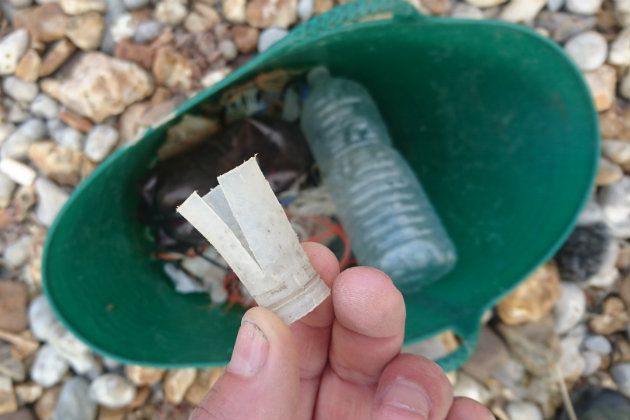Plastic pollution in the ocean – what can we do about it?
By 2050 our oceans will contain more plastic than fish - a haunting vision of a polluted world and one that we can all help to prevent, writes Mike Short, ecologist at the Game & Wildlife Conservation Trust

Mike wants to see plastic cartridge wads, like those he found during the beach clean, phased out
I recently saw a shocking image highlighting one of the perils of all that plastic litter that is drifting around our oceans. The photograph, which showed the skeletal remains of a dead juvenile albatross — a decaying pile of feathers and bone with its body cavity crammed full of plastic waste — has apparently been doing the rounds for several years. Though I had a broad understanding of some of the underlying issues associated with the global plastic pollution problem, this distressing photograph of what is arguably the world’s most enigmatic seabird encouraged me to dig deeper. Sadly, the scale of the problem is far, far worse than I’d realised.
- Ocean plastic pollution is now regarded as one of the greatest environmental threats on Earth and it is rightly rocketing up the international agenda.
- Globally, 311 million tonnes of plastic were produced in 2014 and that is predicted to double over the next 20 years.
- In Europe,, only 30 per cent of a total of 25.8 million tonnes of waste plastic generated in 2014 were recycled.
- More than 8million tonnes of plastic gets dumped into our oceans every year.
Illegal dumping and poor waste management
It has been estimated that 80 per cent of marine plastic originates from terrestrial activities, by illegal dumping and poor waste management, industrial activity, poorly filtered wastewater, coastal littering, storm-water discharge, sewer overflows and all that unsightly rubbish that gets washed into the sea via our rivers. The rest comes from maritime sources.
Plastic debris comes in all shapes and sizes, and this determines both its environmental impact and dispersal. New modelling analysis of the pathway of plastic released from the UK shoreline shows that most of the plastic that doesn’t end up washed on our own beaches ends up in the Arctic. It has been estimated that some 5 trillion pieces of plastic are floating on our oceans, weighing in at around 236,000 tonnes. However, alarmingly, this is believed to constitute only one per cent of the total hoard of plastic bound up in our oceans, the remainder being locked within the water column, scattered on the ocean floor and inside contaminated marinelife.
Plastic present in a third of UK-caught fish
The ingestion of plastic litter has already been reported in more than 250 marine species. A Plymouth University study published last year found that plastic was present in a third of UK-caught fish, including cod, haddock and mackerel.
Toxic fallout for our children and grandchildren
The question now is what will this ingested plastic do to us? According to research by the Ellen MacArthur Foundation, by 2050 our oceans could contain more waste plastic (by weight) than fish. Through our propensity for plastic, we’ve been trading the future health of our oceans for the convenience of today. As a result, our children — and theirs, and theirs — now face some ghastly toxic fallout.
Shocked by the scale of the problem and recognising the part I’ve played in it, I’ve joined the charity Surfers Against Sewage (SAS), a grass-roots movement dedicated to the protection of our oceans, beaches and wildlife. Since its formation in 1990, SAS has successfully lobbied the Government for cleaner seas and is currently working towards a vision of plastic-free coastlines, using its Protect Our Waves All Party Parliamentary Group to urge politicians to invoke stronger policies to stop plastic waste entering the environment.
Plastic pollution from shotgun cartridge wads
In October, I joined an SAS co-ordinated beach clean at Compton Bay on the Isle of Wight with one of my daughters. Along with 83 other adults and hordes of children, we spent several hours bagging up plastic debris. The usual plastic waste items were gathered — bottles, bottle tops, polystyrene, discarded rope, food bags and packaging, but more poignant to this keen angler and shooter were the tangled masses of monofilament fishing line and rusting hooks and colourful plastic fishing floats.
I couldn’t help thinking that, when floating, the translucent plastic shotgun cartridge wads that were found must be dead ringers for tasty squid to any hungry seabird. Isn’t it time the shooting industry completely phased out the damn things?








